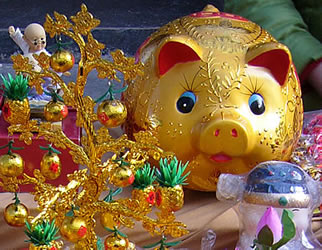Search
Related Articles
- Chinese New Year
- 2007 Year of the Pig
- Golden Pig Year baby boom auspicious or suspicious
- Lunar Calendar
- Chinese Astrology for 2007
- Chinese Zodiac and Signs
Sponsor Ad
Chinese Culture >> Chinese New Year
Chinese New Year, Year of the Pig
By: Pavika WIlson
The Chinese Lunar Calendar follows the lunar year where the years
are arranged in major cycles of 60 years, and the 12 year cycles (each with a
different animal) are repeated. This year is the
Year of the Pig (or Boar).
Those born in 1923, 1935, 1947, 1959, 1971, 1983, 1995, and of course 2007 are
born under the sign of the pig. According to legend, Buddha asked animals to
meet him on
Chinese New Year. Twelve animals came – the Rat, the Ox, the Tiger,
the Rabbit, the Dragon, the Snake, the Horse, the Sheep, the Monkey, the
Rooster, the Dog, and the Pig. So he named each year after them claiming that a
person born under that year would have similar characteristics to the animal.
Persons born under the Year of the Pig work very hard, have excellent manners,
are loyal friends and enjoy luxuries.
 February 18, 2007 is the first day of a 15 day
Chinese New Year celebration.
Because it is the most important holiday in China, people take weeks of holiday
time from work to prepare for and celebrate the New Year. A lot of effort and
preparation goes into making the New Year celebration festive. Superstition and
tradition play a great role in the celebration. Red is the favorite color
amongst Chinese people. Red symbolizes fire which legend says drives away evil
spirits and bad luck. People dress in red, decorate with red and children are
even given red envelopes of “lucky” money. Fireworks light up the night sky and
tradition say it is to help ward away evil spirits. Live blooming plants
represent rebirth and new growth. Mounds of oranges and tangerines are typically
given as gifts when visiting family during the two week celebration.
February 18, 2007 is the first day of a 15 day
Chinese New Year celebration.
Because it is the most important holiday in China, people take weeks of holiday
time from work to prepare for and celebrate the New Year. A lot of effort and
preparation goes into making the New Year celebration festive. Superstition and
tradition play a great role in the celebration. Red is the favorite color
amongst Chinese people. Red symbolizes fire which legend says drives away evil
spirits and bad luck. People dress in red, decorate with red and children are
even given red envelopes of “lucky” money. Fireworks light up the night sky and
tradition say it is to help ward away evil spirits. Live blooming plants
represent rebirth and new growth. Mounds of oranges and tangerines are typically
given as gifts when visiting family during the two week celebration.
Of course there would be no celebration without a wonderful banquet.
Traditionally families gather together to share large meals throughout the
Chinese New Year celebration. But the biggest feast is usually held on New
Year’s Eve. Not only is the banquet shared by family as a sign of respect, the
feast is also prepared for deceased family ancestors. The foods that are eaten
signify different aspects of life and must be consumed to attain the meaning.
Lotus seed signifies male offspring, Ginkgo nut represents silver, dried bean
curd and Black seaweed -wealth and happiness, Bamboo shoots translates to
“wishing that everything be well”. Whole fish is served representing
togetherness and abundance and chicken for prosperity. Everything should be
whole and uncut representing togetherness. The most important Chinese New Year
food is uncut long noodles representing long life. The tremendous amount of food
represents abundance and wealth.
Chinese New Year would not be complete without the lantern festival which
usually marks the ending of the festivities. Lanterns are hung in temples, and
are carried in the evening to a parade. Many lanterns are beautifully hand
painted with nature themed designs or scenes from history. Usually a dragon
dance will take place where a large number of people hold up a dragon made of
paper or silk that could stretch as long as a hundred feet through the streets.
Chinese New Year is not only celebrated in China but is also celebrated in the
United States. Asian communities in San Francisco and New York have parades,
banquets, and firework shows to celebrate as they do in China. Families also
gather to have elaborate feasts, pay respect to their ancestors and ring in the
New Year with good fortune.
Pavika Wilson writes for NCE. An online party store featuring Chinese New Year Decorations and Valentine's Day Decorations for holiday parties and celebrations

